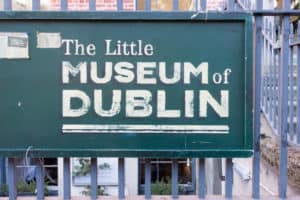The Craftsmanship of Irish Jewellery: Exploring Traditional Designs and Symbols

Updated On: April 28, 2024 by Raghda Elsabbagh
The artistry and craftsmanship that imbue Irish jewellery with its unique charm hold a storied place within the narrative of Irish tradition and culture. Integral to this heritage are the revered Claddagh rings and the intricate Celtic knots, each with their own history and significance. From these symbols of love and loyalty to the detailed work that showcases the creativity of Irish artisans, this craftsmanship is a testament to a legacy of skill passed through generations.
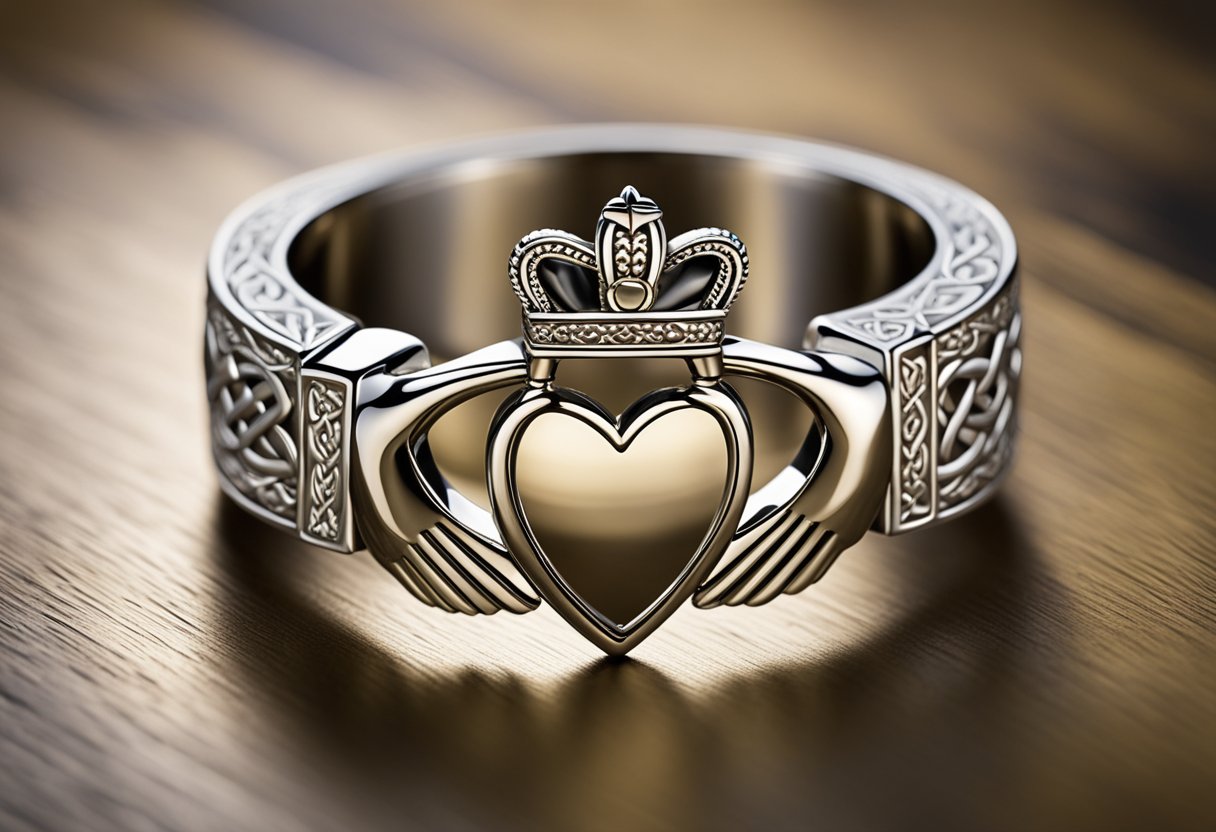
At the heart of Irish jewellery lies a deep-rooted connection to the island’s past—a confluence of art, legend, and cultural symbolism that has transcended time to influence contemporary fashion. The interweaving lines of the Celtic knotwork and the emblematic Claddagh design embody both the enduring nature of Irish history and the personal expressions of the wearer. With meticulous techniques and choice of materials, today’s craftsmen honour the age-old traditions that continue to make Irish jewellery an object of fascination and endearment.
Table of Contents
The Historical Context of Irish Jewellery
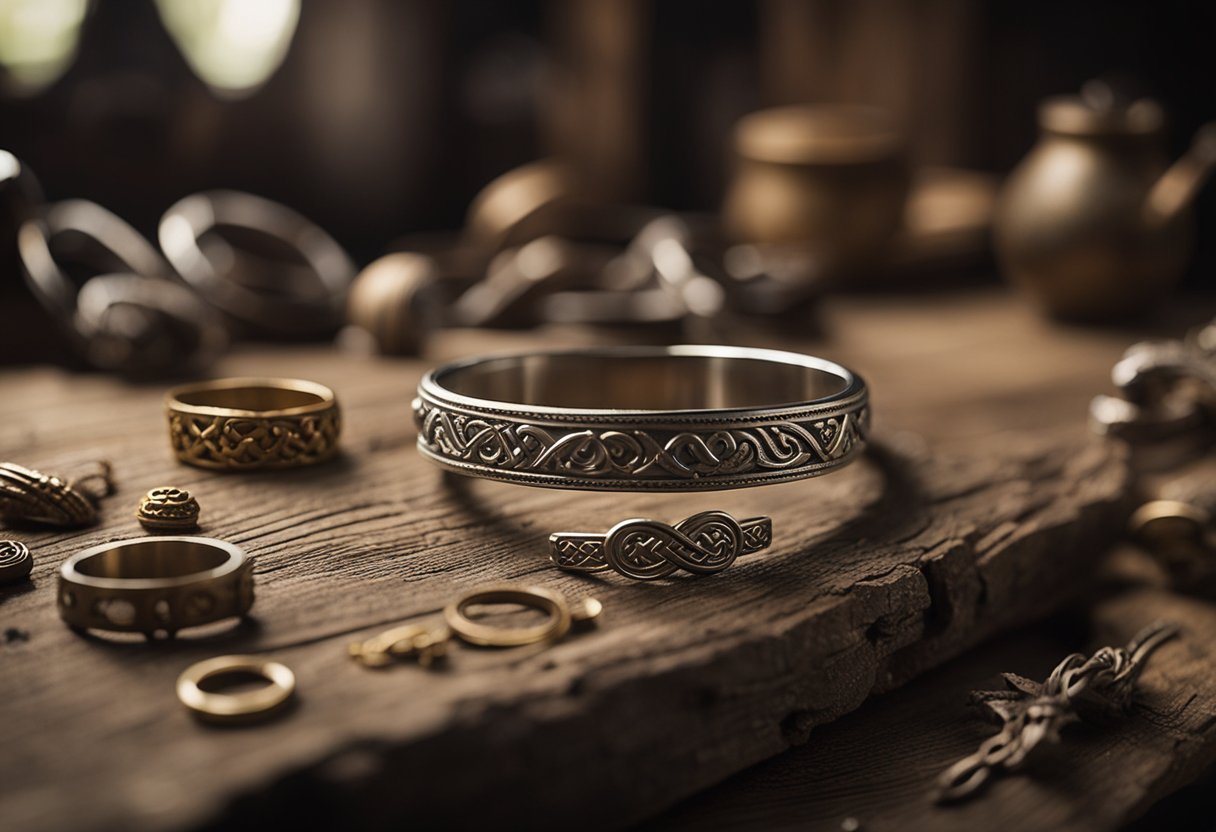
As we explore the rich tapestry of Irish jewellery, it’s crucial to understand its historical backdrop, which spans from the ancient Celtic period to the symbolic designs we recognise today.
Ancient Roots and Celtic Influences
The craft of Irish jewellery finds its roots deep in Ireland’s history, with Celtic culture having a profound impact. The Celts were skilled artisans known for their distinctive artwork, characterised by intricate spirals and knot patterns. The La Tène period marked the emergence of a unique Celtic style, with Ireland becoming a significant repository for gold artefacts, surpassing finds elsewhere in Europe. This era’s torcs and spirals showcase the creativity of Celtic metalwork that became a cornerstone of our cultural heritage.
The Rise of Claddagh and Celtic Jewellery Designs
Our cultural heritage further evolves with the story of the Claddagh ring, a symbol of love, loyalty, and friendship. Originating in the 17th century in Galway, it has been suggested that a man named Richard Joyce, upon his release from slavery at the hands of pirates, created the first Claddagh ring. This iconic design, along with the enduring Celtic knots, signifies the lasting influence of Irish roots and Celtic symbols on our craftsmanship. The jewellery’s interwoven lines that have no start or finish represent everlasting life and love, reflecting the timeless nature of our artistic legacy.
Symbols of Love and Loyalty
In Irish jewellery, love, friendship, and loyalty are richly symbolised through time-honoured designs, such as the Claddagh ring and Celtic knots. These icons not only embody deep emotional sentiments but also communicate relationship status and personal values.
The Claddagh Ring
The Claddagh ring is steeped in Irish tradition, with its distinctive design consisting of two hands clasping a heart beneath a crown. Each element symbolises a core value: the hands represent friendship, the heart signifies love, and the crown denotes loyalty. This ring can be worn in various ways to indicate the wearer’s relationship status, offering a visual testament to love and connection.
The origins of the Claddagh ring trace back to the fishing village of Claddagh in Galway, where it emerged in the 17th century. The ring’s design is often associated with eternal love and enduring relationships. When worn on the right hand with the point of the heart facing outward, it suggests the wearer’s heart is open. If the point faces inward, it symbolises that the wearer’s heart is taken. On the left hand, the ring indicates engagement when the heart points outward and marriage when it faces inward, intertwining the concepts of love, friendship, and loyalty.
Celtic Knots and Their Meanings
Celtic knots are renowned for their infinite pathways, symbolising the timeless nature of the human spirit and the enduring quality of love. These knots, with no beginning or end, often adorn Irish jewellery, representing eternal love and the interconnectedness of life. They can be found in various forms—the Trinity knot, the Dara knot, and many others—each with its unique symbolism intertwined with Irish heritage.
The intricate patterns of Celtic knots embody the uninterrupted cycle of life and the unbreakable bonds of love and friendship. Prominent in Irish culture, these symbols frequently celebrate heritage and personal connections, often gifted to represent unity and fidelity within relationships. They remind us that our bonds of friendship and love transcend time, reflecting our yearning for lasting connections.
Irish Jewellery in Art and Legend
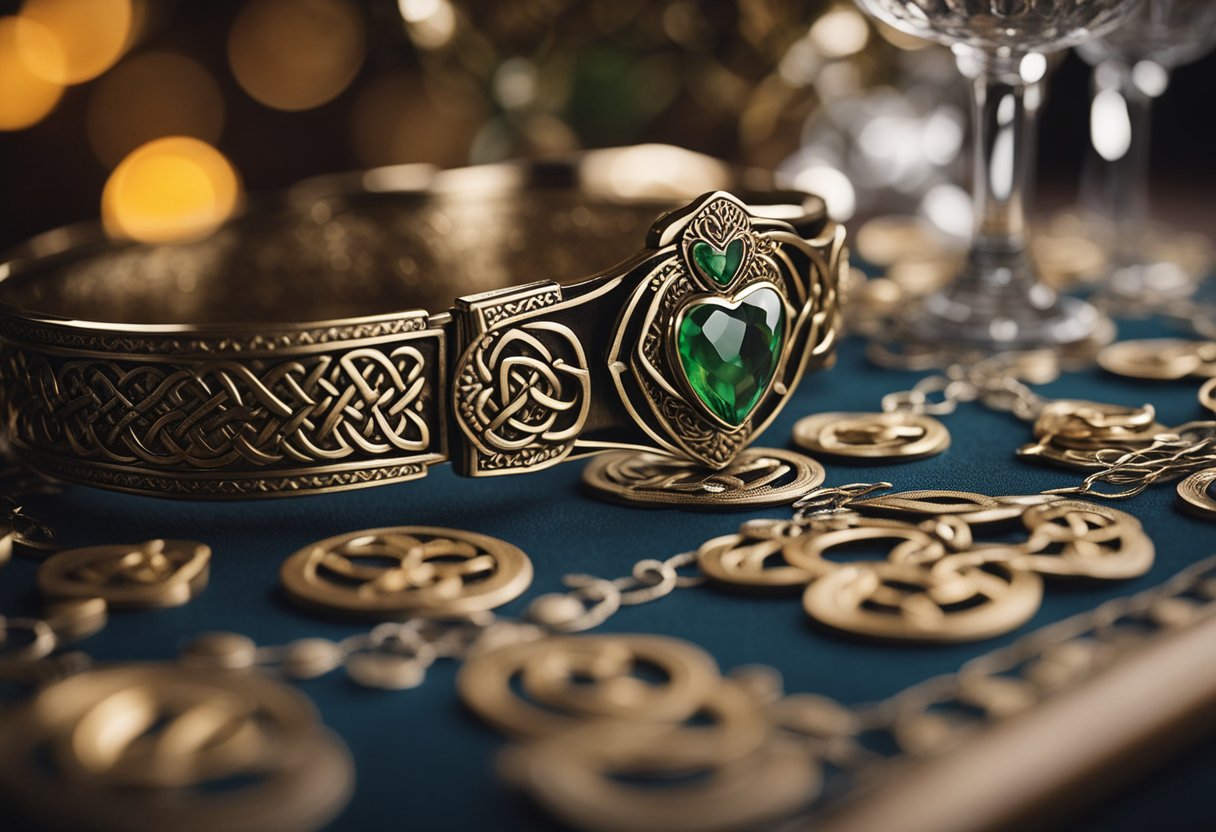
Irish jewellery possesses a rich heritage woven into its art and legends. Its designs aren’t merely decorative but are steeped in history and symbolism that resonate through Irish culture.
The Book of Kells
The Book of Kells is often linked with the zenith of Celtic design. This illuminated manuscript is a splendid specimen of medieval artistry, featuring elaborate ornamental details that have inspired contemporary Irish jewellery designs, particularly pendants. The art found within its pages is emblematic of Ireland’s aesthetic heritage, with each knot and spiral holding meanings that transcend their visual appeal.
Mythology and Folklore
Irish jewellery is profoundly influenced by the country’s rich mythology and folklore. Legends of heroes and ancient gods often feature symbolic motifs that are captured in today’s jewellery pieces. For instance, St. Patrick’s Day is symbolised by the shamrock, and many jewellery items incorporate this symbol to represent the teachings of St. Patrick. Furthermore, other Irish symbols, such as the Claddagh, embodying love, loyalty, and friendship, anchor themselves in tales of fishermen and mystical encounters, ensuring the continuation of these legends through the artistry of jewellery.
Design Elements of Irish Jewellery
In this section, we explore the intricate design elements that make Irish jewellery truly unique, from the materials used to the symbolic patterns that carry centuries of heritage and meaning.
Metalwork and Gemstones
Irish jewellery is renowned for its exquisite metalworking, particularly in materials like gold and sterling silver. Traditional pieces, such as Celtic crosses and Claddagh rings, are often crafted from gold, offering a timeless sheen that complements the complex intertwining patterns prevalent throughout Celtic design. Artisans frequently incorporate gemstones such as Connemara marble, a unique green stone from the west of Ireland, and various birthstones, adding a personalised and colourful touch to their creations.
Unique Motifs and Styles
The design of Celtic jewellery often features distinctive motifs, with Celtic knotwork being one of the most recognisable. The interlaced patterns symbolise eternal life and the interconnectedness of all things. Claddagh rings embody the themes of love, loyalty, and friendship through hands clasping a heart topped with a crown. This iconic design has been cherished for generations and continues to be a significant emblem of Irish identity and kinship.
Cultural Significance and Symbolism
In our exploration of Irish jewellery, we uncover the deep cultural significance and rich symbolism that these artefacts carry. Each piece is not just an adornment but a token of Ireland’s soul, intertwining faith, heritage, and identity.
Faith and Spirituality
The imprint of faith on Irish jewellery is indelible. The Shamrock, a three-leafed plant, is intrinsically linked with the Holy Trinity and St. Patrick, Ireland’s patron saint. It’s a powerful emblem of Irish Christianity, reflecting themes of faith and spirituality that resonate deeply within Irish culture. Similarly, the Trinity Knot, or Triquetra, comprises a trio of interlaced arcs, symbolising concepts that come in threes, be it the Father, Son and Holy Spirit or the interconnectedness of earth, water and sky.
Heritage and Identity
Irish jewellery serves as a tangible connection to one’s ancestry, with pieces like the Claddagh ring representing love, loyalty, and friendship—an ethos central to Irish identity. Designs such as the intricate Celtic Knots also tell a story of interconnectedness and eternity, fundamental aspects of Irish heritage. These adornments celebrate the persistent thread of cultural heritage through the ages, articulating a narrative of survival and pride. The very craft of Irish jewellery-making, embracing symbols like the Celtic cross and the Tree of Life, echoes the reverence for nature and the artistic legacy that Ireland’s culture upholds.
Irish Jewellery as Fashion
Irish jewellery has long transcended the shores of its origin, becoming a staple in fashion circles worldwide and a testament to timeless elegance.
From Celebrities to Cultural Icons
Irish jewellery, from the beloved Claddagh rings to intricate Celtic knots, has been adorned by celebrities and fashion icons, solidifying its place as a symbol of beauty and elegance. The Claddagh ring, with its distinctive design featuring two hands clasping a heart topped with a crown, has been spotted on the fingers of various influential personalities, symbolising love, friendship, and loyalty. The Claddagh’s rich history and emotional significance render it the perfect gift, bridging the gap between fashion statement and cultural emblem.
Celtic knots, with their endless loops, are synonymous with eternal beauty. They boast a seamless elegance that has caught the eyes of the fashion-conscious, making these designs popular choices for statement pieces.
Our fascination with Irish jewellery lies not only in its visual appeal but also in the stories and traditions that influence each piece. As we embrace these symbols of Irish heritage, we find that they seamlessly integrate with contemporary fashion, offering a touch of sophistication and meaning to our ensembles, making us participants in preserving and celebrating a rich cultural legacy.
Crafting Techniques and Materials
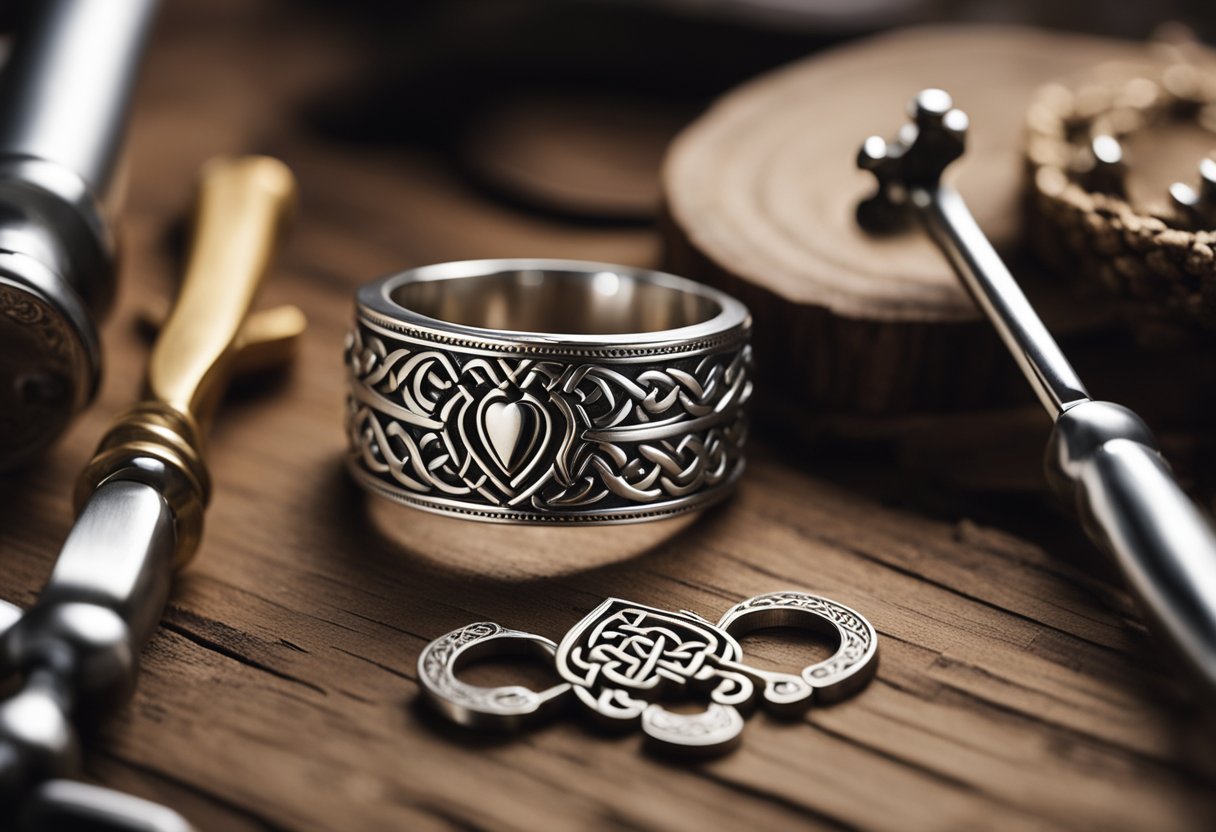
In the creation of Irish jewellery, meticulous craftsmanship and the use of high-quality materials stand out. Our artisans combine time-honoured methods with contemporary design, ensuring every piece is not just jewellery but a piece of art.
From Goldsmith to Modern Maker
Traditionally, a goldsmith was the master of crafting Irish jewellery, using gold as a primary material to forge items of beauty and symbolism. The timeless techniques passed down through generations focused on delicate handiwork and detailed embossing, which can still be observed in iconic pieces like Claddagh rings and Celtic knots. Gold remains a favoured metal due to its lasting quality and the way it beautifully captures the intricacies of Celtic design.
Modern makers at companies like the Irish Jewellery Company incorporate both these age-old skills and modern technology to shape their creations. Advanced tools and precise machining work alongside hand-crafting to ensure each curve and carving is executed flawlessly. The result is a fusion of the past and present—a testament to evolving Irish jeweller expertise yet rooted strongly in historical significance.
Tools and Techniques
- Hand-carving: Refined over centuries to create complex patterns.
- Lost-wax casting: An ancient practice still utilised for detailed pieces.
- Computer-aided design (CAD): Ensures precision in intricate motifs.
Materials
- Gold (yellow, white, rose): Continues to be popular for its durability and lustre.
- Sterling silver: A versatile and more accessible metal option.
- Gemstones: Often used to embellish and add a touch of colour.
By honouring the heritage of Irish goldsmiths and embracing contemporary crafting methods, we maintain a connection to our cultural roots while producing jewellery that meets modern aesthetic and quality standards.
Personal and Social Expressions
Irish jewellery stands not merely as a decorative statement but as an emblem of personal significance and cultural identity. It embodies profound expressions ranging from individual love to communal ties, anchoring its wearers within a tradition richly woven with meaning.
Jewellery for Relationships and Special Occasions
Claddagh Rings: The Claddagh ring endures as the ultimate token of affection. Representing love (the heart), friendship (the hands), and loyalty (the crown), this hallmark of Irish craftsmanship is often exchanged in relationships and on occasions like engagements and weddings. It is also an endearing gift for friends or family, symbolising a deep bond.
Celtic Knots and Eternity Bands: Eternity is a concept often captured in the unending loops of the Celtic knot. These intricate designs are not only a testament to our heritage but also resonate as metaphors for everlasting love and the interconnectedness of life. They commonly adorn wedding rings and are chosen to represent the continuity of commitment.
Whether as a testament to one’s romantic commitment or as a cherished heirloom, each piece tells a story — a narrative that is both deeply personal and reflective of a collective historical and social tapestry. Irish jewellery, thus, serves as a bridge connecting the intimate milestones of our lives with the larger canvas of our shared heritage.
Maintaining Tradition in Contemporary Irish Jewellery
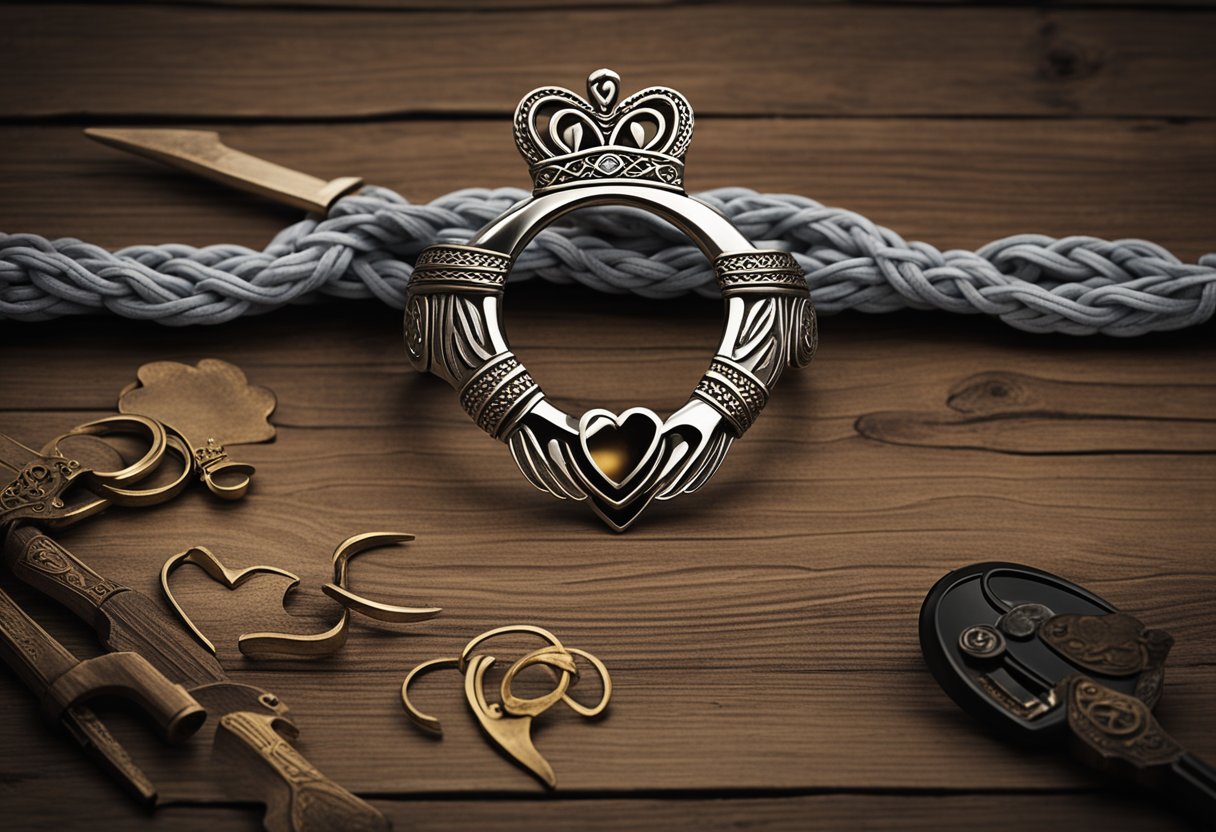
We recognise the delicate balance between innovation and tradition in crafting contemporary Irish jewellery. Highlighting the ways these timeless elements are preserved, we’ll discuss the marriage of emerging trends with enduring classics, specifically focusing on the renowned Claddagh rings and the Celtic knots.
Emerging Trends and Timeless Classics
Claddagh Jewellery: This iconic symbol of Irish heritage continues to be a significant part of Irish jewellery, representing love, friendship, and loyalty. The central heart denotes love, the hands symbolise friendship, and the crown stands for loyalty. Contemporary artisans have managed to maintain this traditional symbolism while introducing unique twists that reflect current trends. For instance, the traditional Claddagh ring may now be found with exquisite detailing or integrated into more modern jewellery pieces to signify relationship status, yet its rich historical significance remains untouched.
Celtic Knots: Equally embedded in tradition are the intricate patterns of Celtic knots featured in Irish jewellery. Despite evolving design techniques, these knots remain a staple in contemporary pieces. Their interwoven appearance is emblematic of the interconnectedness of life and eternity, a narrative that continues to resonate with admirers of tradition and history.
As we craft and wear modern interpretations of these symbols, we ensure the core tenets of Irish legacy endure. Our approach to combining historical reverence with innovative designs secures the place of Irish jewellery in the modern landscape while honouring its rich cultural roots.
Choosing Your Irish Jewellery
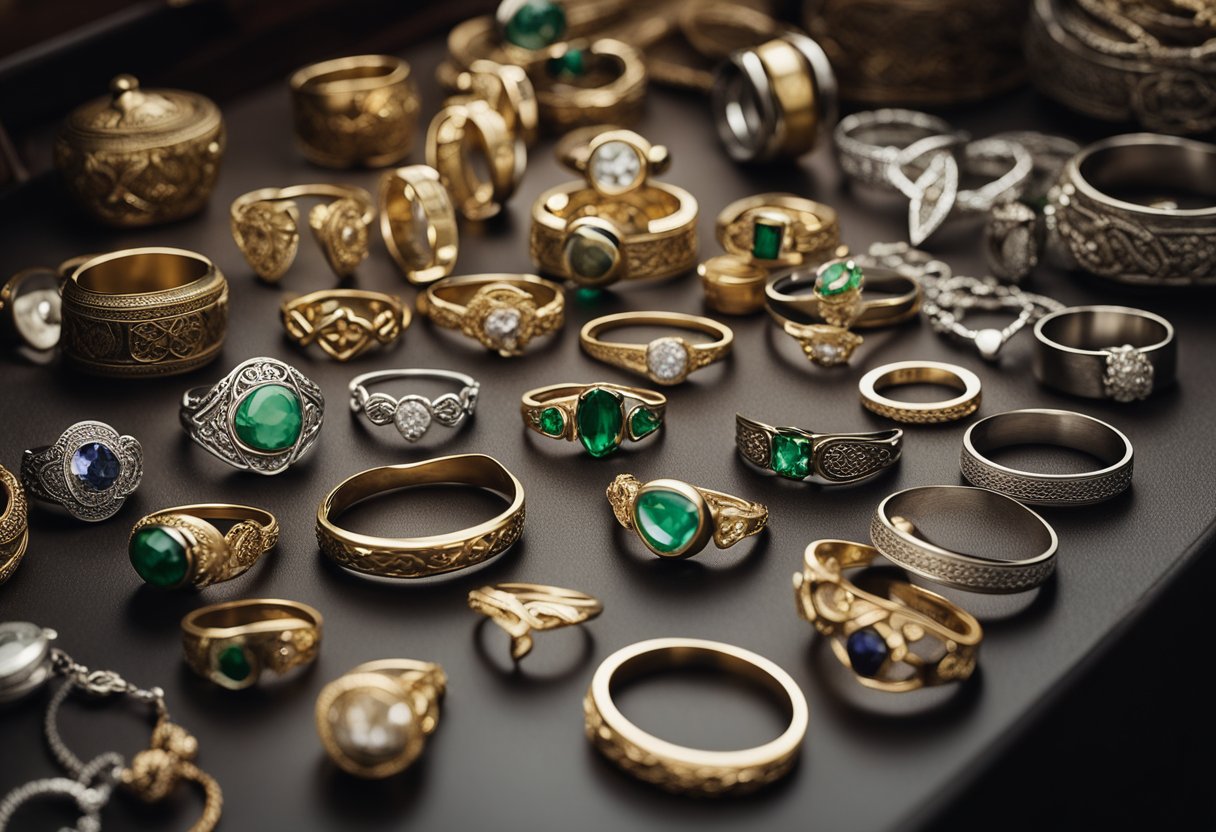
When looking to acquire Irish jewellery, it’s paramount to comprehend the significance of quality and authenticity. From the romantic Claddagh ring to ornate Celtic engagement rings and intricate bracelets, each piece embodies a deep cultural heritage.
Understanding Quality and Authenticity
We place great value on the authenticity of Irish jewellery, recognising its importance in sustaining a rich tradition. When selecting a Claddagh ring or any other piece of Irish jewellery, such as bracelets, earrings, or pendants, it’s critical to ensure the quality and authenticity are up to par.
Materials: Begin with the material. Authentic Irish jewellery is usually fashioned from sterling silver, gold, or sometimes rose gold. Occasional pieces feature mesmerising birthstones.
Craftsmanship: The skill of the artisan is evident in the intricate patterns and sturdy construction of the jewellery. Look for hallmarks that guarantee that your selection, be it a Celtic engagement ring or an Irish Claddagh bracelet, is made according to the highest standards.
Design: The quintessential Claddagh design incorporates symbols for love (heart), friendship (hands), and loyalty (crown). The complexity of Celtic knots and patterns, often found in pendants and earrings, offers a timeless appeal.
To verify authenticity, consider purchasing from reputable Irish jewellers or suppliers known for their commitment to genuine Irish craftsmanship. It’s advisable to research and learn about the Irish hallmarking system, which is a mark of quality and authenticity.
In our selection process, we are mindful of each piece’s origin, ensuring that it tells a story through its design and heritage. By investing in authentic Irish jewellery, we contribute not only to our personal collection of meaningful adornments but also to the preservation and celebration of Irish culture and artisanship.
Conclusion
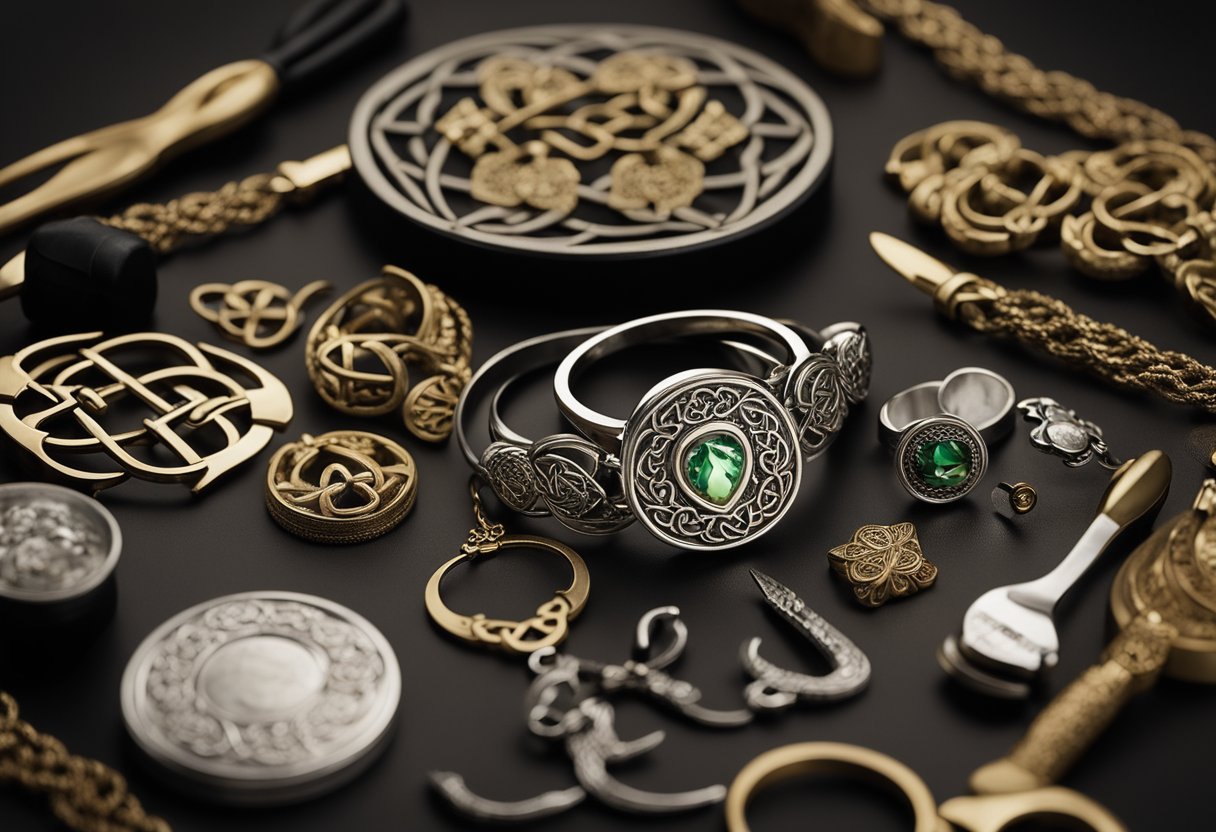
We’ve explored the intricate artistry of Irish jewellery, marking the connection and interconnectedness that these pieces symbolise. The Claddagh ring, with its timeless message of love, loyalty, and friendship, continues to be an emblem of Irish heritage worldwide. As we examined this cherished symbol, we discovered how it encapsulates family bonds and lasting relationships.
The twisting paths of Celtic knots also carry profound meaning, with each loop reflecting life’s everlasting continuum. These designs have become synonymous with Irish culture, reminding us of our shared ancestry and the strength found in unity.
Irish jewellery stands not just as beautiful adornment but as a testament to the country’s legacy, crafting traditions that span centuries. It holds a mirror to the values we cherish, echoing our deep-rooted history and respect for craftsmanship.
As we share this knowledge, we celebrate the hands that have shaped such treasures and the stories they convey. This art form bridges the past with the present, ensuring that the beauty of Ireland continues to resonate far beyond its shores.
Frequently Asked Questions
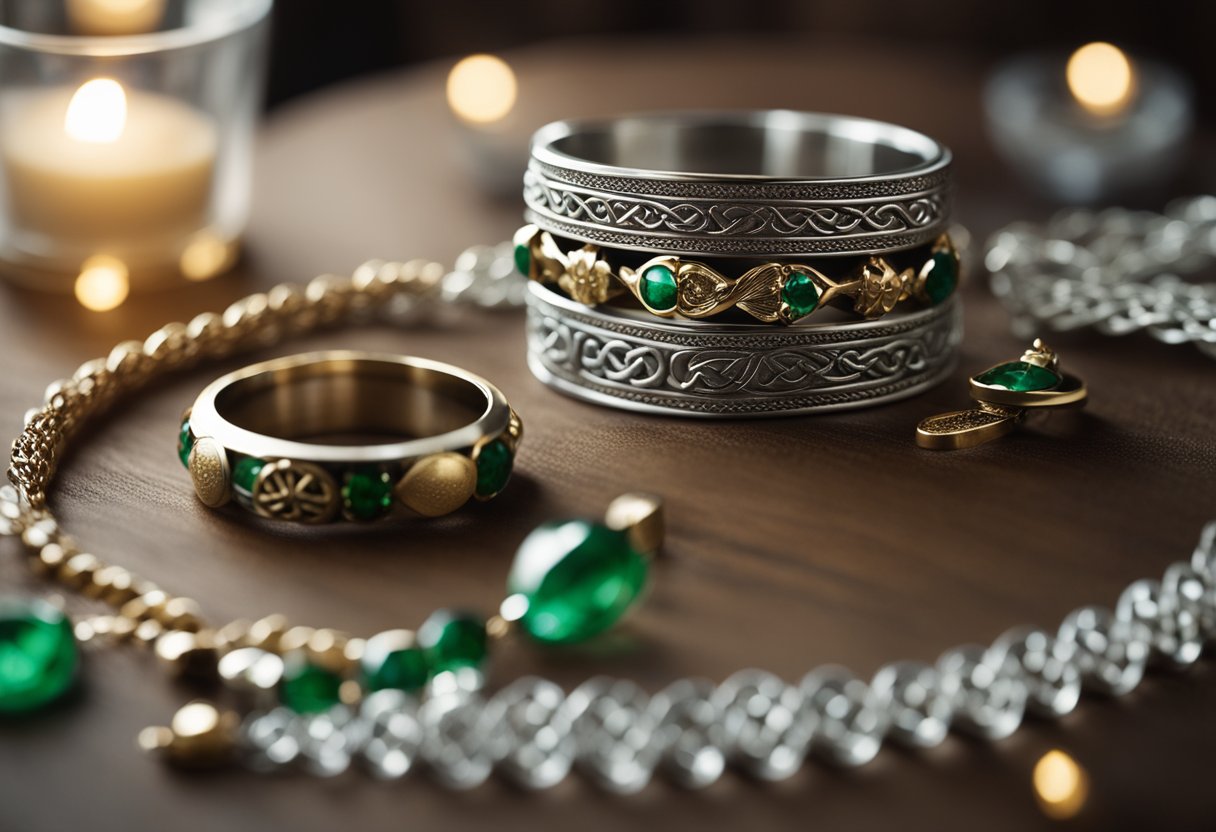
Irish jewellery is steeped in tradition and symbolism. In this section, we’ll address some of the most common queries about the craftsmanship and meanings behind some of Ireland’s most iconic pieces.
What is the significance of the Claddagh ring design?
The Claddagh ring design holds great significance in Irish tradition; it features two hands clasping a heart topped with a crown, symbolising friendship, love, and loyalty. This ring can serve various roles in one’s life, from a sign of friendship to a wedding band, depending on how it’s worn.
How should one properly wear a Claddagh ring?
Wearing a Claddagh ring is tied to one’s relationship status. If you’re single, wear it on your right hand with the heart pointing outwards. If you’re in a relationship, wear it on your right hand with the heart pointing inwards. For engagement, it’s worn on the left hand with the heart pointing outwards, and for marriage, it’s on the left hand with the heart facing inward.
What should one look for when purchasing a gold Claddagh ring?
When purchasing a gold Claddagh ring, one should look at the quality of craftsmanship and purity of the gold. Authentic Irish hallmarks and a maker’s mark ensure the ring’s origin and quality. It’s essential to choose a ring that carries these symbols of authenticity.
Can you explain the symbolism behind Celtic knots in Irish jewellery?
Celtic knots are prevalent in Irish jewellery, representing eternal life and endless love. These interlaced patterns, which have no beginning and no end, are thought to protect against evil spirits. Their intricate designs are a hallmark of traditional Celtic artistry.
How can the history of Celtic jewellery inform its appreciation today?
Understanding the history of Celtic jewellery, which dates back over 2,000 years, enhances appreciation of its artistry. The intricate designs often have ancient meanings associated with nature, spirituality, and the cosmos, reflecting the deep connection our ancestors had with the world around them.
What distinguishes Celtic jewellery from Scottish and Irish origins?
Celtic jewellery from Irish origins often features symbols like the Claddagh, Trinity Knot, and the Irish Harp, each with its own historical importance. In contrast, Scottish Celtic jewellery typically incorporates designs like the Luckenbooth and Scottish Thistle, icons deeply rooted in Scotland’s cultural heritage.





